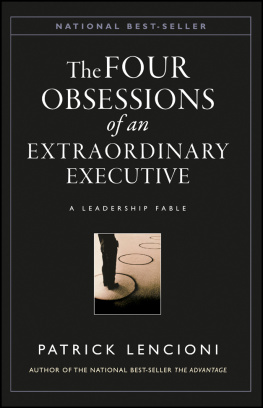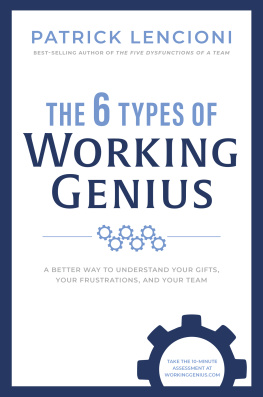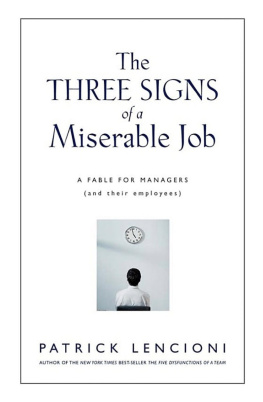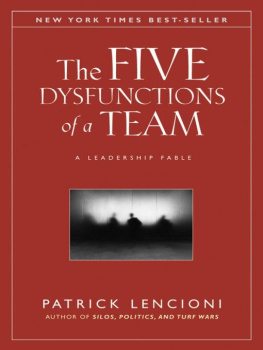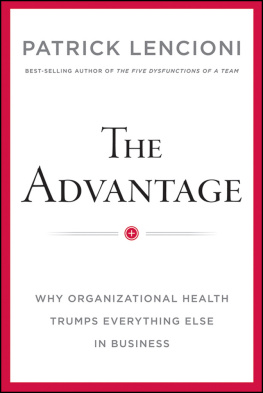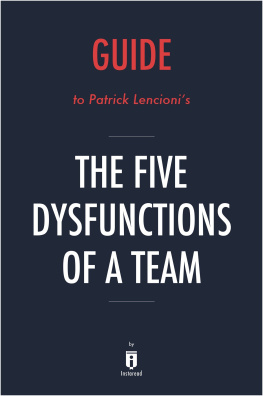
The Four Obsessions of an Extraordinary Executive
A Leadership Fable
Patrick Lencioni

Also by Patrick Lencioni
The Five Temptations of a CEO
The Five Dysfunctions of a Team
Death by Meeting
Overcoming the Five Dysfunctions of a Team
Silos, Politics, and Turf Wars
The Truth About Employee Engagement
The Three Big Questions for a Frantic Family
Getting Naked
The Advantage
The Ideal Team Player
Copyright 2000 by John Wiley & Sons, Inc. All rights reserved.
Published by Jossey-Bass
A Wiley Imprint
989 Market Street, San Francisco, CA 94103-1741 www.josseybass.com
No part of this publication may be reproduced, stored in a retrieval system, or transmitted in any form or by any means, electronic, mechanical, photocopying, recording, scanning, or otherwise, except as permitted under Section 107 or 108 of the 1976 United States Copyright Act, without either the prior written permission of the publisher, or authorization through payment of the appropriate per-copy fee to the Copyright Clearance Center, Inc., 222 Rosewood Drive, Danvers, MA 01923, 978-750-8400, fax 978-646-8600, or on the Web at www.copyright.com. Requests to the publisher for permission should be addressed to the Permissions Department, John Wiley & Sons, Inc., 111 River Street, Hoboken, NJ 07030, 201-748-6011, fax 201-748-6008, or online at http://www.wiley.com/go/permissions.
Limit of Liability/Disclaimer of Warranty: While the publisher and author have used their best efforts in preparing this book, they make no representations or warranties with respect to the accuracy or completeness of the contents of this book and specifically disclaim any implied warranties of merchantability or fitness for a particular purpose. No warranty may be created or extended by sales representatives or written sales materials. The advice and strategies contained herein may not be suitable for your situation. You should consult with a professional where appropriate. Neither the publisher nor author shall be liable for any loss of profit or any other commercial damages, including but not limited to special, incidental, consequential, or other damages.
Readers should be aware that Internet Web sites offered as citations and/or sources for further information may have changed or disappeared between the time this was written and when it is read.
Jossey-Bass books and products are available through most bookstores. To contact Jossey-Bass directly call our Customer Care Department within the U.S. at 800-956-7739, outside the U.S. at 317-572-3986, or fax 317-572-4002.
Jossey-Bass also publishes its books in a variety of electronic formats. Some content that appears in print may not be available in electronic books.
Library of Congress Cataloging-in-Publication Data
Lencioni, Patrick, 1965
The four obsessions of an extraordinary executive: a leadership fable / Patrick Lencioni.1st ed.
p. cm.
ISBN 978-0-787-95403-1 (acid-free paper)
1. ExecutivesFiction. I. Title.
HD38.2 .L46 2000
658.4'09dc21
00-009560
For Joel, a coach and a leader through and through
(19591983)
THE FOUR OBSESSIONS OF AN EXTRAORDINARY EXECUTIVE
Rich OConnors detractors said he was lucky. Others believed he had a natural gift for management and leadership.
Little did they know.
INTRODUCTION
If everything is important, then nothing is.
No one understands the power of this saying more than a person who leads an organization. Whether it is a multinational corporation, a department within a larger company, or a small entrepreneurial venture, every organization provides its leader with more distractions and concerns than one person can handle.
The key to managing this challenge, of course, is to identify a reasonable number of issues that will have the greatest possible impact on the success of your organization, and then spend most of your time thinking about, talking about, and working on those issues.
But what are they? Before we can identify them, it is important to understand what is ultimately necessary for organizational success.
I believe that all successful organizations share two qualities: they are smart, and they are healthy. An organization demonstrates that it is smart by developing intelligent strategies, marketing plans, product features, and financial models that lead to competitive advantage over its rivals. It demonstrates that it is healthy by eliminating politics and confusion, which leads to higher morale, lower turnover, and higher productivity.
As important as both of these topics are, I have found that most leaders spend the majority of their time and energy making their organizations smarter, with relatively little effort directed toward making them healthier. This is understandable considering the predominant focus of business schools and business media. It is regrettable, however, when one considers the powerful and unique attributes of organizational health.
First, healthy organizations have a way of making themselves smarter. Even if their ideas are temporarily inferior to those of competitors, they are usually humble and efficient enough to recognize their deficiencies and make changes in their plans before it is too late. On the other hand, plenty of anonymous and forgotten companies have squandered intellectual advantages because of infighting, lack of clarity, and other problems that plague unhealthy organizations.
Second, healthy companies are far less susceptible to ordinary problems than unhealthy ones. During difficult times, for instance, employees will remain committed to a healthy organization and stay with it longer, ultimately working to reestablish competitive advantage.
Finallyand this point is criticalno one but the head of an organization can make it healthy. While executives often successfully delegate responsibility for strategy, technology, marketing, or finance to their direct reports, they cannot assign responsibility for their organizations cultural well-being to anyone but themselves.
And so, as odd as it may seem, it is actually more important for leaders to focus on making their organizations healthy than on making them smart.
But dont misunderstand me. Not for a second am I saying that issues like strategy, product innovation, and marketing are unimportant. They are indeed critical and deserve a great deal of mindfulness from any executive team. Its just that these topics receive a wildly disproportionate amount of attention from well-meaning and intelligent executives who somehow cannot find the time and energy to focus on making their organizations healthy.
Why does this happen? Because organizational health is relatively hard to measure, and even harder to achieve. It feels soft to executives who prefer more quantitative and reliable methods of steering their companies. It also entails a longer lead time to implementation than does a technical or marketing strategy, which yields more immediate results and gratification.
But perhaps most important of all, organizational health is often neglected because it involves facing realities of human behavior that even the most committed executive is tempted to avoid. It requires levels of discipline and courage that only a truly extraordinary executive is willing to embrace.
The purpose of this book is to help executives understand the disarming simplicity and power of organizational health and the four actionable steps that allow them to achieve it. It begins with a tale of two companies, a healthy one fighting off a potential virus, and an unhealthy one searching desperately for the cure.
Next page
